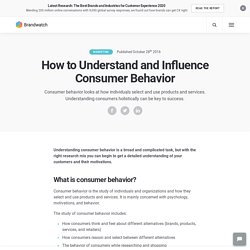

How to Understand and Influence Consumer Behavior. Understanding consumer behavior is a broad and complicated task, but with the right research mix you can begin to get a detailed understanding of your customers and their motivations.

What is consumer behavior? Consumer behavior is the study of individuals and organizations and how they select and use products and services. It is mainly concerned with psychology, motivations, and behavior. The study of consumer behavior includes: How consumers think and feel about different alternatives (brands, products, services, and retailers)How consumers reason and select between different alternativesThe behavior of consumers while researching and shoppingHow consumer behavior is influenced by their environment (peers, culture, media)How marketing campaigns can be adapted and improved to more effectively influence the consumer These considerations are influenced by three factors: Personal factors – A person’s interests and opinions.
Generation Z Characteristics: 5 Infographics on the Gen Z Lifestyle. Just when many companies are finally starting to understand millennials, a new generation is starting to emerge.

Generation Z—people who were born from 1995 onwards—is making its presence known as people from this generation are starting to enter the workforce and earning their own income. Marketers and market researchers still have a lot of work to do to deepen their understanding of this generation. Here are five infographics that paint a picture of the Gen Z landscape. Watch the Webinar Now: Putting the “Customer” in Customer Experience. 1.Their media consumption habits differ from previous generations—even millennials. Vision Critical conducted an exclusive study that exposes the changing media consumption habits of younger consumers. Some notable stats about the Generation Z characteristics from the infographic: 2. Many studies have suggested that millennials are looking for great experiences, not great products. 3.
What makes the Gen Z employee tick? 4. 5. From the infographic: How To Win Over Generation Z, Who Hold $44 Billion Of Buying Power. From baby boomers to Gen X to millennials, savvy brands have largely been able to craft their messaging to appeal to a wide variety of generations that have become viable consumers over the years.

However, because of their young age, one cohort that is often overlooked altogether when it comes to marketing strategies is Generation Z, the age group following millennials. While many brands have written off Gen Z as little more than kids who are addicted to their smartphones, according to the National Retail Federation, Gen Z holds a whopping $44 billion in buying power. With so much pull in the marketplace, companies that cater to these teens could find themselves stepping into an opportunity that could catapult their brand to new heights. Keeping Gen Z top of mind while creating advertising campaigns might very well give companies the competitive edge they’re looking for. Online Shopping vs. In-Store: How America Shops in the Digital Age. What are you more likely to buy online versus in-store?

Are there certain items that you just need to physically see and touch first? Are there some things that are easier to order from your phone or PC? That's what the team from Signs sought to find out in their latest study. They asked almost 1,000 Americans about their purchasing habits, and their comfort in using online platforms for various items. Their findings uncovered some interesting insights - for example, Millennials are twice as likely as Baby Boomers to utilize daily deals websites, and almost 20% of Americans now use a social media marketplace as their preferred method of shopping. The study also looks at key items people shop for online, the reasons behind digital buying, and more insights to help inform your eCommerce approach. You can read the full study here, or take a look at the findings in the infographic below.
Consumers Are Spending More Per Visit In-Store than Online. What Does This Mean for Retailers? Getty The growth of online shopping casts a long shadow over a surprising trend: consumers spend significantly more per visit in-store than online.

The trend was validated yet again in a recent First Insight Report which found that 71 percent of all shoppers surveyed spent $50 or more when shopping in-store. This compares to only 54 percent of respondents spending more than $50 when shopping online. Emotion plays a role in shopping behavior. There is a human side of in-store shopping and shoppers crave that visceral experience. Generation Z Tech Insight. US Retailers Revamp Loyalty Schemes for the Amazon Era. NEW YORK — With private fitting rooms, members-only stores and clever apps, US department stores are reinventing their old and tested loyalty programmes to fend off the challenge from e-commerce giant Amazon.com Inc. and other online rivals.

Over the past two years, major US retailers, including Macy's, Nordstrom, Kohls Corp. and others, have spent billions of dollars to overhaul existing programmes or launch new loyalty schemes. According to estimates compiled by market intelligence firm Beroe, the US loyalty programme market was worth between $47 billion and $55 billion in 2018 in terms of spending by companies and sector analysts expect it to keep growing by 2 percent to 4 percent a year between 2018-2020. Data from research firm LoyaltyOne showed retailers now invest at least 2 percent of their total revenue on loyalty programmes and double that or more on related customer targeting and analytics.
Department stores and apparel retailers typically invest more than the others.